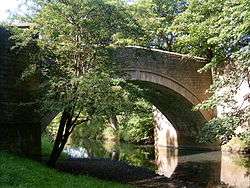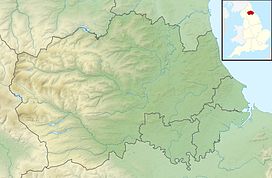River Gaunless
The River Gaunless is a river of County Durham in England. Its name was given by the Vikings, who found no major uses for it and thus Gaunless, meaning 'useless', became fixed.[1]
| River Gaunless | |
|---|---|
 The River Gaunless in the grounds of Auckland Castle. | |
 Location of the mouth within County Durham | |
| Location | |
| Country | England |
| District | County Durham |
| Physical characteristics | |
| Source | |
| • location | Copley |
| • coordinates | 54°37′12″N 1°52′12″W |
| • elevation | 230 m (750 ft) |
| Mouth | |
• location | River Wear, Bishop Auckland |
• coordinates | 54°40′15.60″N 1°40′10.21″W |
• elevation | 70 m (230 ft) |
Formed just south of the village of Copley, by the confluence of Arn Gill (to the south, coming west from south of Langleydale Common) and Hindon Beck (to the north and coming east from Langleydale Common), the Gaunless wends its way east, passing the settlements of Butterknowle, Cockfield and Evenwood and through West Auckland before skirting the south and east of Bishop Auckland on its way to meet the River Wear.
The Gaunless Viaduct, built in 1825, was the tallest viaduct on the South Durham & Lancashire Union Railway.
An extension of the Copley Met.Office weather station has been placed at the head of the river at Copley Lead Mill to study its unique climate of frost and snow. It lies in a frost hollow and receives no sunshine between October and March because of its geography.
Settlements
- Copley
- Butterknowle
- Evenwood
- West Auckland
- Bishop Auckland
Tributaries
- Arn Gill
- Hindon Beck
- Cowclose Beck
- Foul Sike
- Cowclose Beck
- Grewburn Beck
- Howle Beck
- Gordon Beck
- Norton Fine Beck
- Oakley Cross Beck
- Hummer Beck
- Dene Beck
- Coundon Burn
Bridges
References
- A Potted History of West Auckland - Martin Connolly